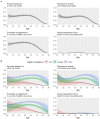The role of age and digital competence on the use of online health and social care services: A cross-sectional population-based survey
- PMID: 35111333
- PMCID: PMC8801649
- DOI: 10.1177/20552076221074485
The role of age and digital competence on the use of online health and social care services: A cross-sectional population-based survey
Abstract
Objective: Online health and social care services are getting widespread which increases the risk that less advantaged groups may not be able to access these services resulting in digital exclusion. We examined the combined effects of age and digital competence on the use of online health and social care services.
Methods: We used a large representative population-based sample of 4495 respondents from Finland. Paper-based self-assessment questionnaire with an online response option was mailed to participants. The associations were analyzed using survey weighted logistic regression, exploring potential non-linear effects of age and controlling for potential sex differences.
Results: Higher age, starting from around the age of 60 was associated with a lower likelihood of using online services for receiving test results, renewing prescriptions and scheduling appointments. Good digital competence was able to hinder the age-related decline in online services use, but only up to around the age of 80.
Conclusions: Our results suggest that older adults are at risk of digital exclusion, and not even good digital competence alleviates this risk among the oldest. We suggest that health and social care providers should consider older users' needs and abilities more thoroughly and offer easy to use online services. More digital support and training possibilities should be provided for older people. It is equally important that face-to-face and telephone services will be continued to be provided for those older people who are not able to use online services even when supported.
Keywords: Digital skills; digital exclusion; older people; online services.
© The Author(s) 2022.
Conflict of interest statement
Declaration of Conflicting Interests: The author(s) declared no potential conflicts of interest with respect to the research, authorship, and/or publication of this article.
Figures
References
-
- Wallis KE, Mulé C, Mittal S, et al. Use of telehealth in fellowship-affiliated developmental behavioral pediatric practices during the COVID-19 pandemic. J Dev Behav Pediatr 2021; 42(4): 314-321. doi: 10.1097/DBP.0000000000000897. - DOI - PubMed
-
- Jaffe DH, Lee L, Huynh S, et al. Health inequalities in the Use of telehealth in the United States in the lens of COVID-19. Popul Health Manag 2020; 23: 368–377. 2020/08/21. - PubMed
-
- Laukka E, Gluschkoff K, Kaihlanen A, et al. [Change in psychiatric outpatient service delivery and leaders’ experiences of factors advancing and hindering digital and remote services during the era of COVID-19] muutos psykiatristen avohoitokäyntien toteutuksessa ja johtajien kokemukset etäasiointia estävistä ja edistävistä tekijöistä COVID 19-aikakaudella. Finnish Journal of EHealth and EWelfare 2021; 13(1): 49-62. 10.23996/fjhw.98228 - DOI
-
- Hyppönen H, Aalto AM. Citizen experiences of e-health and e-welfare services. In: Vehko T, Ruotsalainen S, Hyppönen H. (eds) E-health and e-welfare of Finland checkpoint 2018. Helsinki: National Institute for Health and Welfare (THL), 2019, pp.148–167.
LinkOut - more resources
Full Text Sources


